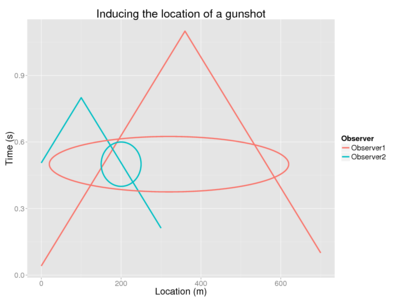Aleppo war sound monitor
| Moderator:Jouni (see all) |
|
|
| Upload data
|
Aleppo war sound monitor is an idea about a mobile-phone-based monitoring network of war-related acticities. It is based on exact timing of sounds of exposions and shootings in relation to the location of monitoring phones. It is based on crowd-sourced information collection with an important feature that the location of a phone is never revealed.
Contents
Question
How to collect monitoring data of war-related activities in difficult conflict areas (such as Aleppo)?
Answer
A mobile phone app can be developed that collects information of noisy events such as explosions and shootings from a conflic area. This is what it would do.
- The app keeps track of the location of a phone.
- The app monitors the sound environment of the phone and identifies war-related sudden noises such as gunfires. It has a pre-stored noise samples that are used to make a preliminary identification of the noise source type.
- The exact timing of the noise is stored, together with the loudness. The precision of the timing is presumably milliseconds, while the loudness is probably in the order of 10 dB, which is not very precise. In addition, the microenvironment (indoors, outdoors, windows closed etc) has a major impact on loudness (easily another 10 dB). These errors can lead to a factor ten bias in the distance estimate of the noise.
- Based on these information and knowledge about the locations of previous noise sources, the phone makes a guess about the location and actual timing of the noise (acknowledging that the recording time has a delay of one second per each 340 m of distance due to the speed of sound in air).
- The guess about the location and timing in four-dimensional space (x longitude, y latitude, z height, and t time) with uncertainty bounds in each dimension (which are wide with the initial guess), together with a guess about the nature of the source, are sent to the server maintaining the system.
- The first guess is immediately sent to all phones using the app. They compare this guess to their own data about the same noise. They produce updated guesses about these parameters, and the uncertainty goes down if data can be collected from different directions and distances from the noise source. In theory, 1 ms precision in timing can lead to 0.3 m precision in location if there are data from different directions.
- If a phone finds the current guess of the noise unlikely, it will automatically produce a competing guess rather than trying to update the first one. Other phones compare there alternative hypotheses and give likelihoods to them based on their own data. Implausible hypotheses are rejected.
- The guesses are stored on the server and published at the level of a single shot. This will give extremely detailed information about the war situation, and it can be used to monitor the events, equipment used, active troops and their actions in real time. It can also be used to analyse events later in court, if needed.
- If a phone is offline or the whole phone network down, the data is stored in the phone until connections are available again.
Rationale
Let's consider a one-dimensional space where sound travels 340 m/s. With an observation of a gunfire, the observer can know the location-timing relations quite precisely, although the exact time and location can only be guessed based on the vague loudness estimate (Figure 1). Also, direction of the sound is not known with a single observation, so it can be to the left or right from the observer. The first observer tells their guess of the gunshot location wih wide uncertainty, including both directions but considering the left direction more likely (red oval).
Another observer can make the same induncion based on own data, and using the first observer's guess can make an updated, much more precise guess (blue oval). With more observers, the location and timing can be induced quite precisely without revealing the locations of the observers.
Mathematically, this can be described in the following way.
- x is location (in metres in a one-dimensional space in this simple example).
- Index 0 means the event (gunshot), and numbers (or i for a generic case) refer to observers.
- s is distance from the noise source (in metres).
- v is speed of sound in air (340 m/s).
- t is time (in seconds).
- A is the noise power (in Watts).
- L is loudness (in decibels).


With no absorbance, the loudness of a sound is inversly proportional to the distance squared. The equations below assume that the estimate of A0 is done near the noise source, from a small distance s0.



A rough estimate can be produced about the distance, because  can be assumed constant, given a certain type of sound (e.g. a rifle gunshot). From the equation we can see that for every 20 dB decrease, the distance will increase tenfold, or equally, for every 6 dB decrease, the distance will indcrease roughly twofold. The distance estimates will become increasingly better when the application learns about case and location-specific nuances based on the crowdsourced distances of noises and default estimates.
can be assumed constant, given a certain type of sound (e.g. a rifle gunshot). From the equation we can see that for every 20 dB decrease, the distance will increase tenfold, or equally, for every 6 dB decrease, the distance will indcrease roughly twofold. The distance estimates will become increasingly better when the application learns about case and location-specific nuances based on the crowdsourced distances of noises and default estimates.

